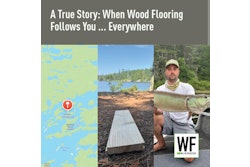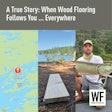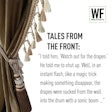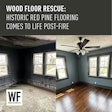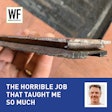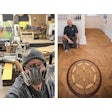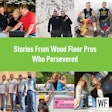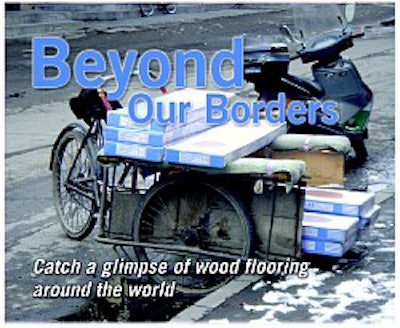
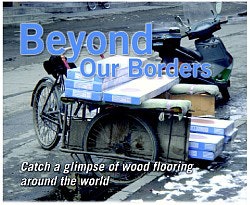
The popularity of wood flooring in the United States and Canada is surging, but we are not alone: It's a trend that spans borders across the globe.
From Mexico to Australia and points between, consumers are increasingly choosing wood floors. Methods and preferences vary around the world—wood flooring contractors often have their own way of doing things, and consumers have their own personal preferences. To catch a glimpse of the industry beyond our borders,Hardwood Floors talked with wood flooring experts from around the globe to see how they do things differently.
South of the Border
When many people imagine Mexican style, a stucco home with intricate patterns of ceramic tiles on the floors may come to mind. These days, however, wood floors are beginning to fit into the floor covering mix. "Ceramic and laminate are most popular,and, little by little, hardwood floors are becoming more popular among people with a high standard of living," explains Mayra Gallardo at Naucalpan deJuárez-based Innovaciones Decorativas SA de CV.
Subfloors in Mexico are almost exclusively concrete slabs, even for the second story of individual homes. Until recently, the wood flooring that was installed was finger block parquet, which could be easily glued directly to the slab. Now,however,tastes are changing, and the Mexican wood flooring contractor is trying to keep up with new products and trends.
"Now they're [consumers] going to strip and plank, and contractors are concerned about it," says Ricardo Pairazaman, a Chester, N.J.-based wood flooring contractor and NWFA technical advisor who took part in an American Hardwood Export Council-sponsored wood flooring school in Mexico City last May. While some leading companies such as Gallardo's are educated about current techniques and products, the vast majority of Mexican contractors find that education is lacking and new products are still relatively hard to come by.
Because the concrete slab subfloors are frequently out of level—sometimes as much as 6 inches over only 5 or 6feet—sleepers are installed over the slabs when a strip or plank floor is required. The sleepers may be 2-by-4s,or they are often 3-by-3 or 4-by-4 timbers that provide more structural support over the uneven slab, says Mickey Moore, technical director for Memphis,Tenn.-based NOFMA: The Wood Flooring Manufacturers Association. Moore also participated in the AHEC school in Mexico City. "It becomes a structural system, as opposed to something you just nail to," he says.
When it comes time for nailing, most contractors still use regular nails and hammers. "What they do is, they have a bucket with a lot of nails. They put a bunch of those in their mouths and start going around and around with a hammer. It's tough," Pairazaman says. "Putting in 1,000 square feet of flooring for them is maybe three or five days' work."
The typical contractor is also lacking when it comes to sanding equipment. Most contractors use old drum sanders that have been repaired and rebuilt in whatever manner they have available to them, and edgers are not frequently used. Instead, contractors frequently use heavy-duty hand-sanders. Small orbital palm sanders are sometimes used, but hand-scrapers are not. The variations in the subfloors also make quality sanding more difficult.
Moisture-cure finish usually bought directly from a local manufacturer is used by the majority of wood flooring contractors, and workers applying the finish rarely wear respirators. "Our installers use knee pads, respirators,ear muffs and glasses," Gallardo says,but she explains that is not the norm. "Most of the installers in Mexico are not used to safety equipment, as it is not required by the law," she says.
The many challenges to a high-quality job-site-finished floor have translated into good business for factory-finished products. Pairazaman estimates that 65percent of the wood floors in Mexico are prefinished. The majority of that flooring is inexpensive Chinese imports.
In general, the quality of wood flooring is not valued over price, Gallardo says: "Unfortunately, people in Mexico don't look for quality and durability." As an example, she says, "Fitness clubs look for an economical floor, so instead of buying red oak, they prefer pine, as it's much cheaper," she explains.
In spite of the challenges, the Mexican wood flooring market continues to grow, by some estimates as much as 20percent a year. Even so, modern hardwood flooring tools and machines are difficult to find and even harder for some Mexican contractors to afford. "It's a growing market, but there are a lot of needs," Pairazaman says.
Down Under
Australia is a growing market for wood flooring, as well, but "timber" flooring,as it's called there, already has a strong presence Down Under: One estimate isthat wood flooring has 18 percent of the Australian floor covering market. Australians love wood and wood products,and the continent's myriad forests provide an abundant local resource forwood flooring. Of the more than 600types of eucalypti trees there, between15 and 20 types are milled for woodflooring.
Those domestic species provide a beautiful spectrum of colors. "In Australia, you typically don't see stained floors at all because they've always had all these different colors," explains Chris Coates, a Novato, Calif.-based sales and marketing representative for Australian wood flooring manufacturer Boral Timber. "If you want a different color, you use a different wood," she explains.
The number of prefinished engineered and floating floors is increasing in Australia, but unfinished solid floors are still commonly installed. Solid flooring is milled as 12-mm or 19-mm flooring, equivalent to 1/2-inch or 3/4-inch, and it comes in long lengths—typically between 12 to 16 feet and sometimes up to 20 feet long. Because of the lengths,the flooring often has to be cut to maneuver it into job sites.
Traditionally, solid 19-mm flooring is blind-nailed, or "secret-nailed," directly to joists, although the use of a plywood subfloor over the joists is spreading. Installers commonly both nail and glue the floor. If the flooring is wider than 3inches, it also is often face-nailed. When the flooring needs to be installed over concrete, "battens" (sleepers) or plywood subfloors may be used, or the installation may be "direct-stick" (glued down). Polyurethane adhesives are the most prominent type used.
The 12-mm flooring is called "overlay," and is usually installed with both pins and adhesive directly to concrete. Parquet-style flooring, or "parquetry," is still relatively popular, and may be a mosaic, finger block-type, or "block" parquetry, which comes either 12-mm- or19-mm-thick, has square edges all around and is used to make "block" pattern (what is referred to in the U.S. as"standard" pattern), as well as herringbone and other patterns.
Design-oriented Australian customers are choosing an increasing number of custom floors. "One emerging trend that we are seeing in the Australian flooring industry is the higher-end type floors—wide boards (200 mm) 8-inch product, decorative parquets, etcetera,"says Malcolm Johnston, the Melbourne,Australia-based project manager—solid hardwood flooring for Boral Timber. "As floors are becoming more of a design point, specifiers are looking for that edge that will make their floor a little different," he says. (For the winners of the inaugural Australian Floor of the Year contest held last August, turn to page 26.)
Australians follow the same sanding routines as contractors in the States,without the same hassles for finding power, as the Australian electrical outlets are all 220 volts. Drum sanders are most common, and the buffers used are high-speed buffers, at 300 rpm instead of the 175-rpm units used here. Dust containment systems are not usually used.
For finishing, "poly" is most common, meaning either a single-pack,which is what's referred to here as moisture-cure finish, or "two-pack,"which is a catalyzed solvent-based finish not commonly used in the States. What's known here as poly—oil-modified polyurethane—is not as common,and is referred to as UMO, or urethane modified oil. Waterborne finishes also have begun to gain acceptance,although their market share is still limited. Whatever the finish used, for most Australian consumers, the glossier, the better. Although required by law, respirators, along with most safety equipment, are not typically used.
Australian customers fully expect their house to be a mess during installation and sanding, but they are demanding when it comes to the finished product, says Brent Sorbet, technical trainer for Toledo, Ohio-based Betco Corporation and its subsidiary, Basic Coatings. Sorbet has traveled extensively in Australia, working with Australian contractors and distributors. "Australian consumers have a higher degree of expectations for the finished product," Sorbet says. "They want a furniture-grade finish on a wood floor." The seamless appearance of the wood floors, with their extremely long lengths, helps contribute to this expectation, he says.
Australian wood flooring guidelines are maintained by a standards organization called Standards Australia. In addition, the Timber Flooring Association of Australia, formed last August, intends to work with the Australian government to develop an inspector certification program, further increasing the professionalism of the Australian wood flooring—or timber flooring—industry.
Orient Express
There's incessant talk in the wood flooring industry about China, always referring to the massive amounts of wood flooring being produced, not being installed. But just as China is a burgeoning market for almost any consumer item, it's also a gargantuan market for installed wood flooring. "The production in China is growing very fast," says Antonio Riccio, who has worked with the Chinese market as export manager for Loba GmbH & Co. KG in Ditzingen,Germany. "A huge part of the production is sold out of China, but the consumption in China is also huge. There is a lot of construction going on."
NOFMA's Moore, who traveled to Hong Kong five times as part of AHEC sponsored training there in the '90s,recalls one wood flooring job site he visited. "The development had about 19acres, with 21 50-story towers with four apartments per floor, and every one of them had a wood floor," he recalls. "That's 2.5 or 3 million square feet of flooring in that development alone. That's a year's production for some companies."
"Virtually no wall-to-wall carpet is used residentially," explains Dave Spreen, president of Kneeland, Calif.based Dave Spreen Enterprises. Spreen has done extensive work with the Chinese wood flooring industry. "The urban population is very mobile, soglueless, click laminates and hardwoods are becoming more popular," he says,explaining that apartments are often rented with a bare floor. Commercial spaces such as restaurants also often have laminate or wood flooring.
Species preferences range from Chinese oak, with an appearance similar to that of North American white oak, to abevy of exotics, such as ipé, jatoba andcumaru. Although Chinese manufacturers are well known for their bamboo flooring, 95 percent of it is shipped outside the country. "The Chinese prefer what they consider to be real hardwood," Spreen says. Strip styles prevail,and wider planks are becoming more popular. Parquet styles are not used.
Virtually every wood floor in China is prefinished, whether it is solid, engineered or floating. High-gloss UV-cured flooring is the norm. "Shiny is beautiful in China … The Chinese do not understand why the U.S. is so much into antique flooring with hand-scraped or distressed textures and the like, or why Europeans like the oil-finished rustic floors," says Gloria Yu, sales representative at Ji Le Mei, a Shanghai-based wood flooring manufacturer. "For the Chinese,something that is new should be like new."
Except for floating floors, most engineered floors and solid floors are nailed down onto plywood over sleepers on a concrete slab. The low cost of labor affects how work is done at the job site—many contractors still use hammers and nails. Spreen recalls showing someone on a wood flooring job site a picture of a pneumatic nailer. "When I told him the price, he said there was noway he could recover the cost in labor savings," Spreen says. "Installation tends to be labor-intensive, and standards are lacking." Safety equipment on the job site is rarely used.
Most Chinese contractors go right to a local manufacturer when they need to buy flooring, and small local retail floor outlets usually buy direct from local factories, as well. Things are changing quickly, Spreen says: "Their economy is not just going through an evolution, it is going through a revolution; things are changing so fast."
In the Old Country
While historical wood floors in castles,palaces and chateaus may be what Americans think of when they imagine wood flooring in Europe, the market there is in large part ultramodern, with some of the most recent styles and products capturing large percentages of the market. A growing interest in natural materials has translated into a growing market for wood flooring in most countries there.
Of course, within Europe, there is great variation between regions and countries, although there are some broad similarities. The vast majority of construction is on concrete slabs,and most homes do not have air conditioning. Prefinished engineered floors dominate—estimates range from between75 and 80 percent of the European market. Almost all solid wood floors are unfinished, and in most countries they are glued down, no matter what their length. There is no one governing body providing grades or standards for the continent.
In some areas of Europe, especially Scandinavia, wood floors have a long tradition. "Many years ago there were big scandals about the problems with hygiene when using carpet. These scandals made hardwood the prime choice for a lot of Scandinavians," says Peter Daneels of flooring manufacturer Par-ky in Menen, Belgium.
Products that were developed in that region have strongly influenced market share there, points out Arne Carlsson, technical manager for Synteko Floor Finishes in Malmo, Sweden,explaining that engineered prefinished floating floors were introduced by Kährs in Sweden in 1941 and later by Tarkett,and waterborne finishes by Bona and Synteko were introduced there in 1975. Today, floating floors dominate the Scandinavian market, and the unfinished floors that are installed are almost always coated with waterborne finish using brushes, rollers or T-bar applicators. Low-gloss finishes are most often used.
Although some say that tastes are beginning to change to darker species, in northern Europe, consumers traditionally choose lighter species, such as maple, pine and beech.
Other areas of Europe do not have such a strong tradition of using wood flooring. While wood flooring is growing in popularity in the United Kingdom, for decades consumers there chosewall-to-wall carpeting as the No. 1 floor covering. That choice still affects the British wood flooring market, experts there say.
"Here in the U.K., we skipped a couple of generations during a love affair with fitted carpets," says Mike Hamer, managing director of Floorstar Ltd. In Banbury, U.K. "Because of that, wealso lost many of the skills of fitting and finishing." The current demand for wood floors outpaces the number of skilled wood flooring contractors, he says.
Phil Darwin of contractor Touch Wood Flooring in Wharfedale, U.K., agrees, and he sees it as a main reason why prefinished flooring is becoming so popular. "I think the reason why it's catching on is because not many people can sand and finish properly," Darwin says. Tradespeople without wood flooring training, such as carpenters, "can just throw it down and walk away," he says. Denis Sullivan, of Campbell Marson & Co. Ltd. in London, adds that "many builders have jumped on the bandwagon, with various results!" The DIY market in the U.K. is growing, as well, mostly with floating glue less installations.
The majority of consumers in the U.K. have traditional tastes, with red oak and white oak still forming a majority of the installations. Some also cite walnut as increasing in popularity. Wide plank is becoming more popular, and the amount of parquet is steadily decreasing, although Sullivan says that traditional parquet is still often chosen in London. In addition to the usual species, Sullivan says that the market is currently"flooded" with prefinished Chinese oak being sold by every avenue, from timber merchants to carpet distributors.
Older homes in the U.K. typically have softwood board subfloors, while new homes have concrete subfloors, many with radiant heat. Most commonly, unfinished floors are "secret nailed" (blind-nailed) over various sizes of timber "battens"(sleepers), particleboard or plywood. Glue-down applications for strip and plank over concrete also are growing, but slowly. "U.K. contractors don't seem to be absolutely convinced yet about stuck-down to concrete," Hamer says. "Increasing demand for non-batten systems is forcing them to change, though."
While traditional oil and wax systems are still used, waterborne finishes dominate the U.K. market. They are often applied with rollers, although T-bar applicators also are used. Consumers in the U.K. are more accepting of visible applicator mark sand sanding marks than consumers in the U.S., Darwin says.
While the decades of preference for carpeting hurt the wood flooring trade in the U.K., in Germany, rigid standards still apply for wood flooring contractors. There, installers must go through an apprenticeship program involving both school and three years on the job with an experienced installer, then take both theoretical and practical tests, says Loba's Riccio. If the apprentice passes, he becomes a "Parkettleger" (wood flooring installer).
Again, prefinished engineered wood flooring dominates,with estimates that it consumes about 80 percent of the German market. White oak and beech are about 70 percent of the species installed, while maple and then tropical woods are there mainder. Floors are either floated or glued down over concrete with a leveling compound. Nails are seldom used.
Approximately 70 percent of finishes used for wood flooring in Germany are waterborne, with 10 percent oil-modified,5 percent moisture-cured, and 15 percent natural oils, Riccio says, adding that new VOC restrictions for waterbased and solvent-based products will take effect in 2007 and 2010. Finishes are either rolled or troweled on, but rolled for the final coat. Oils are sometimes troweled for the last coat but then buffed with a pad while still wet, Riccio adds. Fillers are made on-site using dust from the final floor sanding.
Just south of Germany, the market is substantially different. In Italy, tile flooring is everywhere, but wood floors also are in demand, and the market has some important differences when compared with the rest of the Europe. "In Italy, hardwood floors are considered amedium- to high-class kind of flooring,therefore the level of quality and manufacturing system is by far higher thanthe rest of Europe—and the price, as well," says Luca Bigorra of SLC Technology in Sassuolo, Italy.
There, only 2 percent of the floors are floated, Bigorra says, with 30 percent prefinished engineered and 68 percent solid, although that number is slowly decreasing. Strip and plank dominate,with only 5 percent of floors parquet. Concrete subfloors are prevalent. "Moisture problems in the concrete are well known, moisture is always checked,rules about installation on a concrete subfloor are clear and mainly respected,and there is only one test allowed (calcium carbide)," Bigorra says.
For species, tastes run to the dark and exotic. While oak is often installed,African woods iroko and doussie are also commonly chosen. Teak and South American species also have a substantial presence.
Whereas in many other European countries, contractors often buy from distributors, in Italy, almost all contractors buy direct. Wood flooring distributors can be found only in Rome and Milan, Bigorra says.
Buying direct is a common challenge for distributors across all of Europe,Par-ky's Daneels says. "Commodity items are very difficult to sell for the distributor, as there will always be a mill that offers these products direct,"Daneels explains. As a result, most of the flooring distributors focus on products with added value, he says. That's a focus that wood flooring professionals can relate to, no matter which part of the globe they're from.
On-Site in Mexico City

While at the American Hardwood Export Council-sponsored wood flooring school in Mexico City last May, Harvester’s Greg Fuller got this shot of a job site, where workers were installing parquet that is commonly used there.
Aussie Awards

At the Australian Timber Flooring Expo held in Melbourne last August, attendees voted on the winners of the inaugural Boral Timber Floor of the Year contest. Two winners were chosen—one in the Commercial category and one in Residential.
In the Residential category, the winner was Robert Clague of Northern Suburbs Timber Flooring in Brendale, Queensland. Clague’s floor (pictured at right) is made of blackbutt, which was nailed and glued with a polyurethane adhesive over plywood on top of a concrete subfloor, then coated with three coats of a high-gloss, two-pack solvent-based polyurethane finish. Cork measuring 12 mm (1⁄2 inch) was installed around each panel. “The customer had high expectations, and with only a thought to go off of, this was the outcome,” Clague says, crediting installer Grant Robertson and sander Justin D’Arcy.

In the Commercial category, David Watson of Perth Timber Floors in Mt. Lawley, Western Australia, took home the award. His winner was a select-grade Sydney blue gum strip floor (pictured at lower left) custom-designed for the club house of the Port Bouvard Golf Club, located about 60 miles south of Perth. Designer Barry Small of Bravura Design worked closely with the golf club owners to have floors that flowed through all parts of the clubhouse, says Amanda Watson of Perth Timber Floors. The floor was installed on either side of a riverstone inlay in the lobby, around carpets in a bar, and throughout the restaurant and wine areas, Watson says. The floor was glued and nailed to 12-mm pine plywood over a concrete subfloor and finished with two-pack finish.
Residential Winner Credits:Flooring: Robertson BrothersAdhesive: SikaFinish: Polycure
Commercial Winner Credits:Flooring: Van Dommelen Timber ProductsFinish: PolycureBuilder: Pindan ConstructionDesigner: Barry Small of Bravura Design

















